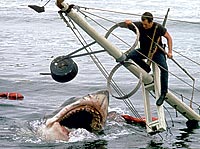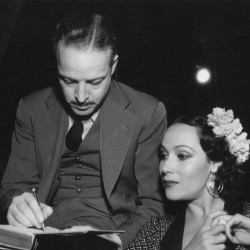Lights, Camera, Music!
A film’s score can convey emotion or mood, and prepare the audience for what’s to come.

Imagining Jaws without its famous score is an effective lesson in how much music affects the emotions and responses audiences have to a film. Photo: Sunset Boulevard/Corbis
The class starts with a simple get-to-know-you exercise as students give their names and hometowns. But there’s a twist: each must also reveal a favorite movie score or soundtrack.
For Carly Rudeen x’10, the answer is easy: Breakfast at Tiffany’s.
“ ‘Moon River’ is my ring tone,” she says with a grin to her classmates, whose own favorites include The Godfather, various installments of the Lord of the Rings trilogy, and Pulp Fiction.
These students are devoting the semester to studying something filmgoers don’t always notice when they watch movies, but that plays a tremendously influential role in their viewing experience: music.
“You really do have to start by saying, ‘This is not something I’m accustomed to doing.’ You have to change the way in which you engage with the films,” says Jeff Smith MA’89, PhD’95, a communication arts professor and movie music expert who teaches Communication Arts 613: Hollywood Film Score: Theory and History.
“A lot of [students] may have seen Star Wars, but they haven’t listened to Star Wars when they watched Star Wars,” Smith says. “We don’t train ourselves to attend to music, in part, because we’re not really supposed to.”
So Smith sets the stage before the lights go down, standing at a piano at the front of the screening room and picking out a lilting — and slightly schmaltzy — tune before showing his students Love in the Afternoon, a 1957 film directed by Billy Wilder.
“That’s what you should listen for. You will hear it many times over the next couple of hours,” he says.
Called “Fascination,” the song first appears as part of the seduction routine of Gary Cooper’s playboy character, is later sung by Audrey Hepburn when her character starts falling for him, and finally swells in the score at the end of the film when he has fallen in love with her, too.
Smith, who studied music as an undergraduate, says he often uses the piano in class to make sure students are “actually hearing what you want them to hear.”
Music plays a powerful role by conveying emotion to movie audiences. “Music can tell us what characters are feeling,” Smith says. “You don’t want the dialogue to be that on-the-nose all the time.”
But music can also set a mood and cue viewers to what they are about to see on screen; imagine the shower scene in Psycho without the shrieking, cacophonous strings or Jaws without the guttural, ominous theme music: “da-dum … da-dum.”
Most students enrolled in the class are communication arts majors, but, says Smith, “There are always a few music students who, when they discover the course, will say ‘What can I possibly do to get in?’ And I like having music students in class. It’s a different perspective, and in some cases, they will know more about the music than I will.”
But because most of the students are film — not music — specialists, Smith takes time to explain the lingo they’ll need to describe and analyze music in films, including tempo (fast or slow), texture (a few instruments versus an orchestra), dynamics (loud or soft), and tone color (such as the difference between a flute and a trumpet). In the end, he says, students learn to actively listen to films as well as watch them.
“A lot of students have said that it does change their habits, the way that they approach the film experience,” he says.
Which film score is Smith’s favorite? Once Upon a Time in the West, he says, which composer Ennio Morricone wrote before filming began on the 1968 spaghetti Western so that director Sergio Leone could play it on the set, allowing actors to walk and gesture in time with the music. “It really becomes a very effective dramatic tool, because it has been conceived as part of the production itself,” Smith says.
Published in the Winter 2009 issue



Comments
No comments posted yet.